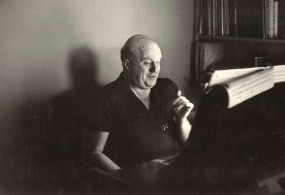Note: This article was originally published on the ACA Website
When ACA Director Gina Genova asked me to write an article about Ben Weber in honor of ACA’s upcoming 75th anniversary celebration, I spent a lot of time staring at my computer, wondering how to begin. Should I start with a description of the highly eccentric man who rarely left his apartment, yet played a major role in New York’s musical life in the 1940s and 50s? Or with some words about the music; or perhaps with stories about my study with him in the four years before his death in 1979? As Ben’s life was full of contradictions and ambiguities, not easily encapsulated in a few catch phrases or sound bites, I decided the best strategy was just to plunge in, do some of each, and hope that what emerged would be a portrait of this unique artist that gives a sense of his true place in American music.
***
 Ben Weber was born in St Louis, Missouri in 1916 and died in New York City in 1979. A self-taught composer, he was the first American to adopt the twelve-tone technique of Arnold Schoenberg. Musicologists consider him one of the most important and influential composers of his generation, and the list of performances and recordings is long and impressive. Orchestral works include pieces premiered and recorded under the batons of Leopold Stokowski and Leonard Bernstein; his chamber and piano works were performed by the instrumental virtuosi of the day, artists and ensembles such as Alexander Schneider, Mieczyslaw Horszowski, Joseph Fuchs and the Juilliard Quartet.
Ben Weber was born in St Louis, Missouri in 1916 and died in New York City in 1979. A self-taught composer, he was the first American to adopt the twelve-tone technique of Arnold Schoenberg. Musicologists consider him one of the most important and influential composers of his generation, and the list of performances and recordings is long and impressive. Orchestral works include pieces premiered and recorded under the batons of Leopold Stokowski and Leonard Bernstein; his chamber and piano works were performed by the instrumental virtuosi of the day, artists and ensembles such as Alexander Schneider, Mieczyslaw Horszowski, Joseph Fuchs and the Juilliard Quartet.
CLICK HERE to read the Full Article
